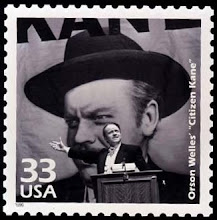I’ve ridden on the Ferris Wheel in Vienna featured in Carol Reed’s The Third Man. I’ve visited the Trevi fountain in Rome that is so memorably eroticized in Fellini’s La Dolce Vita. But despite being to New York City several times, I’ve still never been to the top of the Empire State Building.
I don’t know what the lines were like to reach the landmark’s
scenic heights 75 years ago, but poor Ann Darrow (Fay Wray) took the express route when King
Kong (Schoedsack/Cooper, 1933) saw fit to use the world’s tallest building (at the time) as the site
of his last stand. It’s a tremendous
climax to a film that may show its age around the edges, but has not dated a
bit in its rich, creative vision and sense of dread and fantastic awe.
There have been, of course, remakes since then, but for
some reason, the subsequent versions have meddled with what I’ve always felt was
the horrific center of the story. They’ve
tried to make Kong more “human”, assigning more external emotion to his story
when the point has never been, to these eyes, his unrequited “love”, but his own primal sense of mystery and, by extension, his
larger alienation in a world hostile to him.
Both Jessica Lange’s vapid heroine and Naomi Watt’s spirited
one attempt to draw a real connection with Kong, one that’s trusting and protective. But in seeing it as a relationship to nurture, the subsequent versions reduce his frightening grandeur,
making him less mythic and more mere monkey.
But Fay Wray can’t get free of him fast enough, and there’s never a sign
of remorse or loss at his death in her eyes. Because the world, including her, sees him
simply as a monster, in all its imposing ferociousness. There is nothing
sentimental in how Schoedsack & Cooper portray his plight or his demise.
But that doesn’t mean his final fall isn’t any less poignant, because
through the incredible craftsmanship of visual effects pioneer Willis O'Brien, we the
audience are able to see what Carl Denham & co. can’t—that Kong is a tragic
figure as well as an epic one. Denham’s
last line “It was Beauty killed the Beast” frames the story in cultural
parameters he can’t resist, as huckster and showman. But it’s also laced with contempt and pity, not reverence,
for while Kong was ruler of his world, he was only of value in ours as a
captive for the curious. Kong is Denham's meal ticket, but nothing more than a dumb animal, easily conquered
and reduced to a sound bite or facile metaphor.
A freakish anecdote laying dead on the NYC boulevard.
But we know differently.
And it is this insight, this privilege at a larger view of Kong and his
story, which makes the film so sad, and so glorious. Because Kong's level of expressiveness was only possible through a
triumph of technology, and all the behavioral quirks that he shows, all the
attention to detail that the stop-motion photography brings to remarkable life,
are testament to cinema’s power to terrify, transfix, and enchant. And in that world of the imagination, Kong
does remain king.
Kong has yet to get his own US stamp, but the Empire State Building one was part of the Celebrate the Century issue for the 1930's (Scott # 3185b). The wonderful score for Kong was written by Max Steiner (Scott # 3339), while the Special Effects stamp and Disney's Beauty and the Beast stamp are Scott #s 3772i and 4027 respectively. The Chinese Year of the Monkey stamp was Scott # 3895l while Canada's Fay Wray stamp came out in 2005.
My Top 10 films from 1933
1. Man's Castle (Borzage)
2. Footlight Parade (Bacon)
3. King Kong (Cooper/Schoedsack)
4. Snow White (Fleischer; Betty Boop short)
5. Las Hurdes (Bunuel)
6. Gold Diggers of 1933 (LeRoy)
7. Zero de Conduite (Vigo)
8. Duck Soup (McCarey)
9. Queen Christina (Mamoulian)
10. Dinner at Eight (Cukor)
1




No comments:
Post a Comment